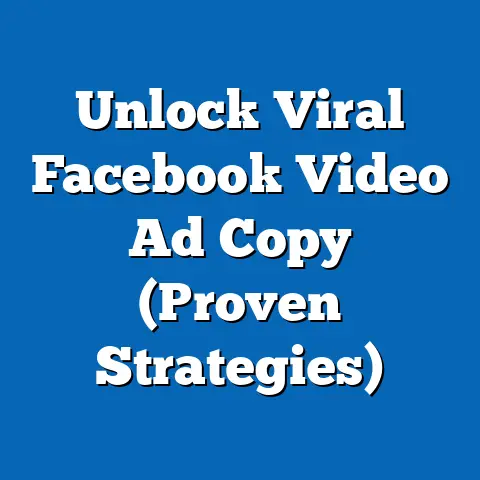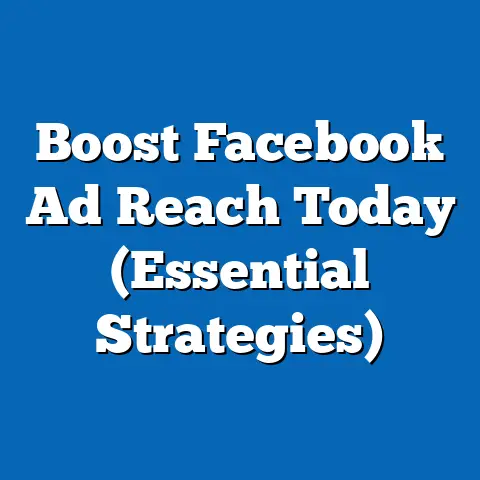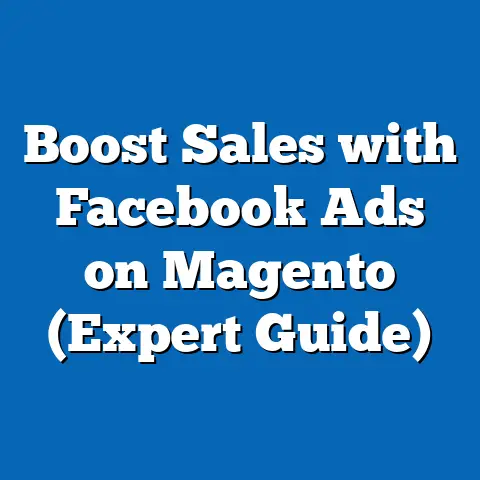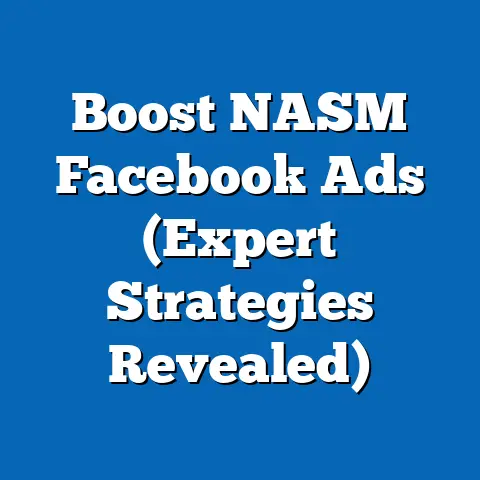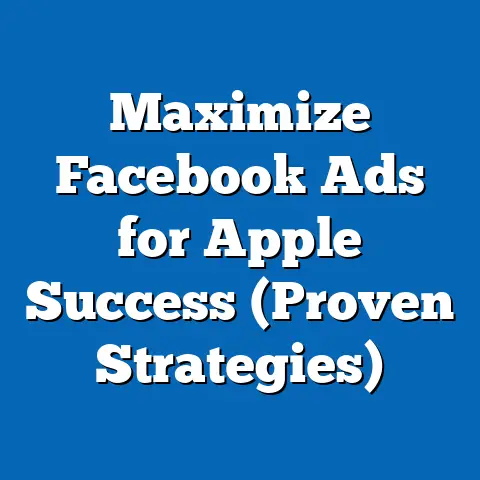Boosting Engagement Without Facebook Ads (Proven Strategies)
Let’s face it, as a digital marketer, I’ve been there. You pour your heart and soul into crafting compelling Facebook content, only to see it disappear into the abyss of the newsfeed, garnering little to no engagement. The frustration is real, especially when you’re staring down a shrinking organic reach while the costs of Facebook ads seem to keep climbing. I’ve heard countless small business owners and marketers voice this same sentiment: “Is it even possible to get noticed on Facebook without spending a fortune on ads?”
The answer, thankfully, is a resounding yes! While Facebook ads certainly have their place, they aren’t the only path to building a thriving, engaged community. In this article, I’m going to share proven strategies that I’ve personally used and seen work for others to boost your Facebook engagement organically, without breaking the bank. We’ll dive deep into content strategy, community building, and leveraging the power of your audience. Get ready to ditch the reliance on paid ads and unlock the true potential of your Facebook presence!
Section 1: Understanding Engagement on Facebook
Before we jump into specific tactics, it’s crucial to understand what we mean by “engagement” and why it matters. It’s more than just vanity metrics; it’s the lifeblood of your Facebook presence.
What is Engagement?
On Facebook, engagement encompasses any interaction a user has with your content. This includes:
- Likes and Reactions: The simplest form of engagement, showing approval or emotion.
- Comments: Demonstrating deeper interest and sparking conversation.
- Shares: Expanding your reach by distributing your content to new audiences.
- Clicks: Driving traffic to your website or other online destinations.
- Saves: Indicating that users find your content valuable and want to revisit it later.
Why Engagement Matters
Engagement isn’t just about feeling good; it directly impacts your brand’s visibility and success on Facebook. Here’s why:
- Increased Reach: Facebook’s algorithm favors content that generates high engagement. When people interact with your posts, the algorithm interprets this as a sign that your content is valuable and relevant, and it will show it to more users. I’ve seen firsthand how a single viral post can dramatically expand a page’s reach, bringing in new followers and potential customers.
- Community Building: Engagement fosters a sense of community around your brand. When you interact with your audience, respond to their comments, and encourage discussions, you create a space where people feel connected and valued.
- Brand Loyalty: Engaged customers are more likely to become loyal customers. By consistently providing valuable content and fostering meaningful interactions, you build trust and strengthen your relationships with your audience.
- Improved ROI: Even without paid ads, increased engagement can drive tangible business results, such as increased website traffic, lead generation, and sales.
How Facebook’s Algorithm Works
Understanding the Facebook algorithm is key to maximizing your organic reach and engagement. While the algorithm is constantly evolving, here are some core principles to keep in mind:
- Relevance: Facebook prioritizes content that it believes is most relevant to each individual user based on their past interactions, interests, and connections.
- Engagement Signals: The algorithm analyzes various engagement signals, such as likes, comments, shares, and time spent viewing a post, to determine its quality and relevance.
- Relationships: Facebook favors content from friends and family, as well as from pages and groups that users frequently interact with.
- Content Type: Different content types, such as videos, images, and links, may be weighted differently by the algorithm.
- Recency: Newer content is generally given more weight than older content.
Takeaway: Engagement is the currency of Facebook. By creating valuable, relevant content and fostering meaningful interactions, you can earn the algorithm’s favor and expand your organic reach.
Section 2: Building a Strong Content Strategy
A strong content strategy is the foundation of any successful Facebook presence. It’s not enough to simply post random updates; you need a plan that outlines what type of content you’ll create, who you’re targeting, and what goals you’re trying to achieve.
Elements of a Successful Facebook Content Strategy
- Define Your Target Audience: Who are you trying to reach on Facebook? What are their interests, needs, and pain points? The more you know about your audience, the better you can tailor your content to resonate with them. I always start by creating detailed buyer personas that outline the demographics, psychographics, and online behavior of my ideal customers.
- Set Clear Goals: What do you want to achieve with your Facebook presence? Do you want to increase brand awareness, generate leads, drive website traffic, or boost sales? Your goals will guide your content strategy and help you measure your success.
- Develop a Content Calendar: Plan your content in advance and create a calendar that outlines what you’ll post, when you’ll post it, and what channels you’ll use. This will help you stay organized and consistent with your content creation. I find that using a tool like Trello or Asana to manage my content calendar helps me stay on track and collaborate effectively with my team.
- Experiment with Different Content Types: Don’t limit yourself to just text updates. Experiment with different content types, such as videos, images, polls, stories, and live streams, to see what resonates best with your audience.
Types of Content That Foster Engagement
- Videos: Videos are incredibly engaging and can capture attention quickly. Consider creating short, informative videos, behind-the-scenes glimpses, or customer testimonials. I’ve found that videos that are less polished and more authentic often perform better than highly produced videos.
- Images: High-quality images can also be very engaging. Use eye-catching visuals that are relevant to your brand and target audience.
- Polls: Polls are a great way to encourage interaction and gather feedback from your audience. Ask questions that are relevant to your brand and industry, and make sure the answer options are clear and concise.
- Stories: Facebook Stories are a great way to share quick, informal updates with your audience. Use them to give behind-the-scenes glimpses, share promotions, or ask questions. I’ve found that using interactive elements like polls and quizzes in my stories can significantly boost engagement.
- Questions: Asking questions is a simple but effective way to spark conversation and encourage your audience to share their thoughts and opinions.
- Behind-the-Scenes Content: People love to see the human side of your brand. Share behind-the-scenes glimpses of your team, your office, or your production process.
- Inspirational Quotes: Inspirational quotes can be highly engaging, especially if they’re relevant to your brand and target audience.
- Contests and Giveaways: Contests and giveaways are a great way to generate excitement and boost engagement. Offer a prize that’s relevant to your brand and target audience, and make sure the entry requirements are clear and easy to follow.
- User-Generated Content (UGC): As we’ll discuss in more detail later, user-generated content is incredibly valuable and can be a powerful way to boost engagement.
The Significance of Storytelling
Storytelling is a powerful way to connect with your audience on an emotional level. Share stories about your brand, your customers, or your industry that are relatable, inspiring, or entertaining. I’ve found that stories that highlight the challenges and triumphs of my customers are particularly effective at generating engagement.
The Role of Authenticity and Relatability
In today’s digital world, people crave authenticity. Be real, be genuine, and be transparent in your communication. Don’t try to be something you’re not. I believe that showing the human side of your brand is key to building trust and fostering meaningful connections with your audience.
Takeaway: A strong content strategy is the backbone of your Facebook presence. By creating valuable, relevant, and engaging content, you can attract and retain a loyal audience.
Section 3: Leveraging User-Generated Content (UGC)
User-generated content (UGC) is any content created by your customers or fans that features your brand. It’s a goldmine of authenticity and social proof that can significantly boost your engagement and credibility.
What is User-Generated Content?
UGC can take many forms, including:
- Photos and Videos: Customers sharing photos or videos of themselves using your products or services.
- Reviews and Testimonials: Customers writing reviews or testimonials about their experiences with your brand.
- Blog Posts and Articles: Customers writing blog posts or articles about your brand or industry.
- Social Media Posts: Customers mentioning your brand in their social media posts.
Benefits of UGC
- Authenticity: UGC is inherently more authentic than branded content because it comes directly from your customers.
- Social Proof: UGC provides social proof that your products or services are valuable and trustworthy.
- Increased Engagement: UGC is often highly engaging because it’s relatable and relevant to your target audience.
- Cost-Effective: UGC is a cost-effective way to generate content because it’s created by your customers.
- Brand Advocacy: UGC can turn your customers into brand advocates who promote your brand to their friends and followers.
Examples of Brands Successfully Utilizing UGC
- GoPro: GoPro is a master of UGC. They encourage their customers to share their adventure videos and photos using the hashtag #GoPro, and they regularly feature the best content on their social media channels.
- Starbucks: Starbucks encourages their customers to share photos of their coffee creations using the hashtag #Starbucks, and they often feature the best photos on their Instagram account.
- Airbnb: Airbnb encourages their guests to share photos and stories of their travel experiences using the hashtag #Airbnb, and they regularly feature the best content on their social media channels.
Strategies for Encouraging Customers to Create and Share UGC
- Run Contests and Giveaways: Encourage customers to create and share content for a chance to win a prize.
- Create a Hashtag: Create a unique hashtag for your brand and encourage customers to use it when sharing content.
- Feature UGC on Your Social Media Channels: Regularly feature the best UGC on your social media channels.
- Ask for Reviews and Testimonials: Ask your customers to write reviews and testimonials about their experiences with your brand.
- Make it Easy to Share Content: Make it easy for customers to share content by providing social sharing buttons on your website and blog.
Takeaway: User-generated content is a powerful tool for boosting engagement, building trust, and turning customers into brand advocates.
Section 4: Creating a Community Through Facebook Groups
While Facebook Pages are great for broadcasting information, Facebook Groups are ideal for fostering a sense of community and encouraging meaningful interactions.
Facebook Group vs. Facebook Page
- Facebook Page: A public profile for businesses, brands, and organizations. It’s primarily used for broadcasting information, sharing updates, and running ads.
- Facebook Group: A community forum where people can connect with each other based on shared interests or goals. It’s primarily used for fostering discussions, sharing information, and building relationships.
Advantages of a Facebook Group
- Increased Engagement: Facebook Groups tend to have higher engagement rates than Facebook Pages because members are more likely to participate in discussions and share their thoughts and opinions.
- Stronger Community: Facebook Groups foster a stronger sense of community because members are actively interacting with each other.
- Targeted Audience: You can create a Facebook Group that’s specifically targeted to your ideal customers.
- Direct Communication: You can communicate directly with your group members through posts, comments, and direct messages.
- Valuable Feedback: You can gather valuable feedback from your group members about your products, services, and marketing efforts.
Steps to Create and Manage a Thriving Community
- Define Your Group’s Purpose: What is the purpose of your group? What topics will you discuss? What goals will you try to achieve?
- Choose a Name: Choose a name that’s clear, concise, and relevant to your group’s purpose.
- Set Clear Guidelines: Set clear guidelines for your group to ensure that it remains a safe and respectful space for everyone.
- Promote Your Group: Promote your group on your Facebook Page, website, and other social media channels.
- Engage with Your Members: Regularly engage with your group members by asking questions, starting discussions, and sharing valuable content.
- Moderate Your Group: Moderate your group to ensure that members are following the guidelines and that discussions remain respectful and productive.
Ways to Engage Group Members
- Ask Questions: Ask questions that are relevant to your group’s purpose and encourage members to share their thoughts and opinions.
- Start Discussions: Start discussions about topics that are relevant to your group’s purpose.
- Share Valuable Content: Share valuable content, such as articles, videos, and blog posts, that are relevant to your group’s purpose.
- Run Challenges: Run challenges that encourage members to participate and achieve specific goals.
- Host Live Q&A Sessions: Host live Q&A sessions where members can ask you questions about your brand, your industry, or your products and services.
- Offer Exclusive Content: Offer exclusive content to your group members, such as discounts, promotions, or behind-the-scenes glimpses.
Takeaway: Creating a Facebook Group is a powerful way to build a thriving community around your brand and foster meaningful interactions with your audience.
Section 5: Utilizing Facebook Live and Interactive Features
Facebook Live and other interactive features offer unique opportunities to engage your audience in real-time and create a more immersive experience.
Benefits of Facebook Live
- Real-Time Engagement: Facebook Live allows you to engage with your audience in real-time, answering their questions and responding to their comments.
- Increased Visibility: Facebook Live videos tend to get higher organic reach than other types of content.
- Authenticity: Facebook Live is a great way to show the human side of your brand.
- Versatility: Facebook Live can be used for a variety of purposes, such as Q&A sessions, product demonstrations, behind-the-scenes glimpses, and live events.
Ideas for Live Sessions
- Q&A Sessions: Host live Q&A sessions where you answer questions from your audience about your brand, your industry, or your products and services. I’ve found that promoting these sessions in advance and collecting questions beforehand can help ensure a lively and engaging discussion.
- Product Demonstrations: Demonstrate how to use your products or services.
- Behind-the-Scenes Glimpses: Give your audience a behind-the-scenes glimpse of your team, your office, or your production process.
- Live Events: Broadcast live events, such as conferences, workshops, or concerts.
- Interviews: Interview industry experts or thought leaders.
Interactive Features
- Polls: Polls are a great way to encourage interaction and gather feedback from your audience.
- Quizzes: Quizzes are a fun and engaging way to test your audience’s knowledge about your brand or industry.
- Events: Facebook Events are a great way to promote your events and encourage people to attend.
Takeaway: Facebook Live and interactive features are powerful tools for engaging your audience in real-time and creating a more immersive experience.
Section 6: Collaborating with Influencers and Partners
Collaborating with influencers and partners can help you reach new audiences and boost your engagement.
What is Influencer Marketing?
Influencer marketing is a type of marketing that involves partnering with influencers, who are individuals with a large and engaged following on social media, to promote your brand or products.
Benefits of Influencer Marketing
- Reach New Audiences: Influencers can help you reach new audiences that you might not be able to reach on your own.
- Build Trust: Influencers can help you build trust with your target audience because they are seen as credible and authentic.
- Drive Engagement: Influencers can help you drive engagement by creating content that is relevant and engaging to their followers.
- Generate Leads: Influencers can help you generate leads by promoting your products or services to their followers.
- Increase Sales: Influencers can help you increase sales by driving traffic to your website or online store.
Finding the Right Influencers
- Identify Your Target Audience: Who are you trying to reach with your influencer marketing campaign?
- Research Influencers: Research influencers who are relevant to your target audience and who have a large and engaged following.
- Check Their Authenticity: Check the influencer’s authenticity by looking at their engagement rates, the quality of their content, and their past collaborations.
- Reach Out to Influencers: Reach out to influencers and ask if they are interested in collaborating with you.
Types of Collaborations
- Sponsored Posts: Influencers create and share content that promotes your brand or products.
- Product Reviews: Influencers review your products or services.
- Giveaways: Influencers host giveaways that promote your brand or products.
- Takeovers: Influencers take over your social media accounts for a day or a week.
- Co-Hosted Events: You and the influencer co-host an event that promotes your brand or products.
Takeaway: Collaborating with influencers and partners can help you reach new audiences, build trust, and boost your engagement.
Section 7: Engaging Through Consistent and Authentic Communication
Consistent and authentic communication is essential for building a strong community and fostering lasting relationships with your audience.
Responding to Comments and Messages
- Respond Promptly: Respond to comments and messages as quickly as possible.
- Personalize Your Responses: Personalize your responses by addressing the person by name and referencing their comment or message.
- Be Helpful: Be helpful and provide valuable information.
- Be Positive: Be positive and upbeat in your communication.
- Thank People for Their Feedback: Thank people for their feedback, both positive and negative.
Personalizing Responses
- Use the Person’s Name: Use the person’s name when responding to their comment or message.
- Reference Their Comment or Message: Reference their comment or message to show that you’re paying attention.
- Ask Follow-Up Questions: Ask follow-up questions to encourage further conversation.
- Share Personal Anecdotes: Share personal anecdotes that are relevant to the conversation.
Transparency and Authenticity
- Be Honest: Be honest and transparent in your communication.
- Admit Your Mistakes: Admit your mistakes and apologize when necessary.
- Show the Human Side of Your Brand: Show the human side of your brand by sharing behind-the-scenes glimpses of your team, your office, or your production process.
Takeaway: Consistent and authentic communication is essential for building a strong community and fostering lasting relationships with your audience.
Section 8: Analyzing Insights and Adapting Strategies
Analyzing your Facebook Insights is crucial for understanding what’s working and what’s not, and for adapting your strategies accordingly.
Using Facebook Insights
- Reach: Track your reach to see how many people are seeing your content.
- Engagement: Track your engagement metrics, such as likes, comments, shares, and clicks, to see how people are interacting with your content.
- Demographics: Track your audience demographics to see who is engaging with your content.
- Best Performing Content: Identify your best performing content to see what resonates most with your audience.
- Worst Performing Content: Identify your worst performing content to see what you should avoid in the future.
Analyzing What Performs Best
- Look for Patterns: Look for patterns in your best performing content. What topics are most popular? What content types are most engaging? What time of day do you get the most engagement?
- Ask Your Audience: Ask your audience what they want to see more of.
- Experiment: Experiment with different content types, topics, and posting times to see what works best.
Adapting Your Content Strategies
- Focus on What Works: Focus on creating more of the content that performs best.
- Eliminate What Doesn’t Work: Eliminate the content that doesn’t work.
- Experiment with New Ideas: Experiment with new ideas to see what resonates with your audience.
- Stay Up-to-Date: Stay up-to-date with the latest Facebook trends and best practices.
Takeaway: Analyzing your Facebook Insights is crucial for understanding what’s working and what’s not, and for adapting your strategies accordingly.
Section 9: Cross-Promotion and Multi-Platform Strategies
Don’t limit your reach to just Facebook. Cross-promote your Facebook content on other social media platforms and leverage multi-platform strategies to drive traffic and engagement.
Promoting Facebook Content on Other Platforms
- Instagram: Share snippets of your Facebook content on Instagram and link back to your Facebook Page in your bio or stories. I often create visually appealing graphics that summarize key points from my Facebook posts and share them on Instagram.
- Twitter: Share links to your Facebook content on Twitter.
- LinkedIn: Share links to your Facebook content on LinkedIn, especially if it’s relevant to a professional audience.
- Email Marketing: Include links to your Facebook content in your email marketing campaigns.
- Website: Embed your Facebook feed on your website.
Maintaining a Cohesive Brand Message
- Use Consistent Branding: Use consistent branding across all of your social media platforms.
- Use a Consistent Tone of Voice: Use a consistent tone of voice across all of your social media platforms.
- Share the Same Values: Share the same values across all of your social media platforms.
Driving Traffic to Facebook
- Run Contests and Giveaways: Run contests and giveaways that require people to visit your Facebook Page to enter.
- Promote Your Facebook Page: Promote your Facebook Page on your website, email signature, and other marketing materials.
- Use Social Sharing Buttons: Use social sharing buttons on your website and blog to make it easy for people to share your content on Facebook.
- Partner with Other Businesses: Partner with other businesses to cross-promote each other’s Facebook Pages.
Takeaway: Cross-promotion and multi-platform strategies can help you reach new audiences and drive traffic to your Facebook Page.
Conclusion
As we’ve explored, boosting engagement on Facebook without relying solely on ads is entirely achievable. It requires a strategic approach, consistent effort, and a genuine desire to connect with your audience. Remember, it’s not just about broadcasting information; it’s about building a community, fostering meaningful interactions, and providing value to your followers.
From crafting compelling content to leveraging user-generated content, creating a Facebook Group, utilizing live and interactive features, collaborating with influencers, engaging in authentic communication, analyzing insights, and cross-promoting your content, there are numerous proven strategies that you can implement today.
While Facebook ads can be effective, they shouldn’t be your only strategy. By focusing on organic engagement, you can build a stronger, more loyal community that will support your brand for years to come. So, ditch the reliance on paid ads, embrace these strategies, and watch your Facebook engagement soar! I encourage you to pick one or two of these strategies to implement consistently over the next month. Track your results and see what works best for your audience. You might be surprised at the impact you can make without spending a dime on advertising.

